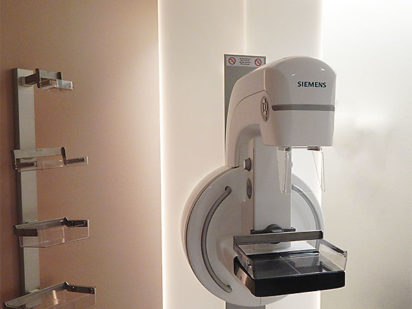(MINOT, ND) – Members of Trinity Health’s mammography team are counting the days ëtil they’re ready to unveil the latest innovation in breast imaging technology. Trinity Health soon will introduce Wide-Angle True Breast Tomosynthesis ñ the most up-to-date 3-dimensional breast imaging system on the market.
Radiologist and Breast Imaging Section Chief Edward Hanjani, MD, says the Siemens 3D system features wide-angle image acquisition that lets physicians detect breast cancer with amazing precision ñ even in cases of dense breast or overlapping tissue.
‘The unique feature of True Breast Tomosynthesis is the wide angle that creates a 3D picture by capturing no fewer than 25 images of the breast from many angles in a wide 50-degree arc,’ Dr. Hanjani explained. ‘The images are assembled into a 3D study of the breast so we can see the breast tissue layer by layer in fine detail.’
Clinical data demonstrates that the addition of 3D digital breast tomosynthesis increases detection of breast tumors. Primary advantages are fewer call backs and less anxiety for patients. Radiologists can rule out abnormalities that might otherwise be deemed suspicious, thus reducing the need for additional testing, which can be worrisome to patients.
‘We expect it to reduce the number of false positives by as much as 30%,’ Radiologist Scott Lewis, MD, noted. ‘These are cases where we see a spot, call the patient back and then see that it was nothing. It should also lower costs by reducing the need for further testing.’
While 2-dimensional digital mammography continues to be an excellent technology for many women, radiologists have long dealt with the phenomenon of dense breast tissue, especially in younger women, which can present a greater challenge when it comes to detecting small tumors. Dr. Hanjani says the 3D tomosynthesis technology gives doctors greater ability to detect and diagnose very small tumors as well as target the size, shape and location of tumors overall. That’s because the wide-angle, multiple-image picture gives a comprehensive 3-dimensional view. Radiologists can scroll through the ‘slices’ looking for abnormalities.
Although the 3D breast imaging revolution has been around for a number of months, Trinity specialists feel good about sitting tight and waiting for the preferred Siemens system. It has received high marks from Trinity’s radiologists as well as visiting doctors who have used it. As Dr. Hanjani put it, ‘The imaging looks more natural ñ more comparable to actual breast tissue, which makes it easier to see detail.’
Lead Mammographer Connie Busch says the 3D system will offer essentially the same mammography experience as the 2D, adding, ‘Early detection is the key to surviving breast cancer. When we find tumors earlier, we’re better able to create treatment plans that are more effective. We think this technology can help us save lives.’
The role of the patient, of course, is to pick up the phone. A woman’s very best defense against breast cancer is early detection and early diagnosis ñ both made possible through an annual screening mammogram.
While Trinity Health has installed its 3D True Breast Tomosynthesis system, Radiology and mammography staff are completing special training and certification prior to offering the service publicly.




